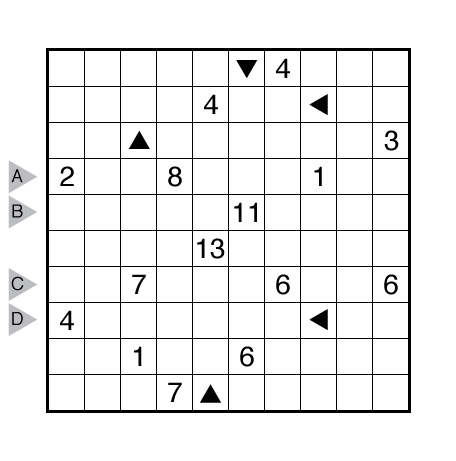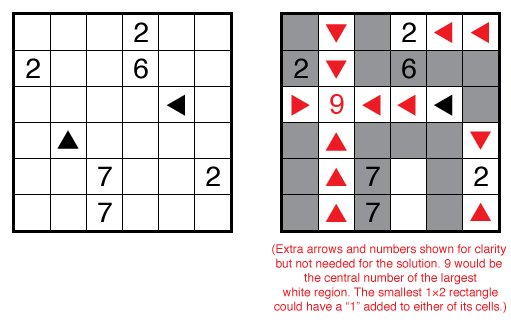Winddraughts by John Bulten
(Note: puzzles during this bonus week are harder than usual; the four puzzles from Monday-Thursday are all about Thursday or Friday level difficulty.)

or solve online (using our beta test of Penpa-Edit tools).
Theme: Hidden
Author/Opus: This is the 43rd puzzle from our contributing puzzlemaster John Bulten.
Rules: Shade some white cells black so that each contiguous white region is a valid Four Winds region (that is, the white region consists of at least two white cells, and has at most one “central” cell where both vertical and horizontal connections are made; if the white region contains a numeric clue, this clue must be the “central” cell and represent the count of all other cells in the region, which must be connected vertically or horizontally to this clue). An arrow clue must belong to a white region and point to its “central” cell (assignment of which cell is “central” is not necessary in one-cell-wide rectangular regions). The contiguous black regions can contain zero, one, or more clues. All clues inside a black region must indicate that region’s area.
Also see this example:

Answer String: Enter the length in cells of each of the black segments from left to right for the marked rows. Separate each row’s entry from the next with a comma.
Time Standards (highlight to view): Grandmaster = 4:45, Master = 8:00, Expert = 16:00
Solution: Answers for this week in this PDF.
Note: Winddraughts is John Bulten’s variation on the puzzles Four Winds and Checkered Fillomino.

A question on the rules. Can an arrow clue point to a black cell or off the grid? For example, could the example have an arrow pointing down in the bottom right cell?
I had assumed this was not allowed when I solved this. Looking back, however, that is not clear from the rules if the region is just a rectangle.
Thanks, David
Thank you, David! The arrow must point to at least one white cell. After that, the next cells in the arrow’s direction can be any color up to the end of the grid; but any white cells touching the arrow clue must be in that line or in one perpendicular line through a central cell.
In Four Winds, there are no colors but just borders, all central cells are numbered givens from 1 on up, and all arrows must be assigned to central givens. Here I’m using the same shapes for white regions (aka I, L, T, X) but loosening up the clues and tightening up the color assignment.
In Quintessence, I have an arrow on the grid edge pointing directly off the grid, so you must have at least one white cell connected off the grid, but that is another story!